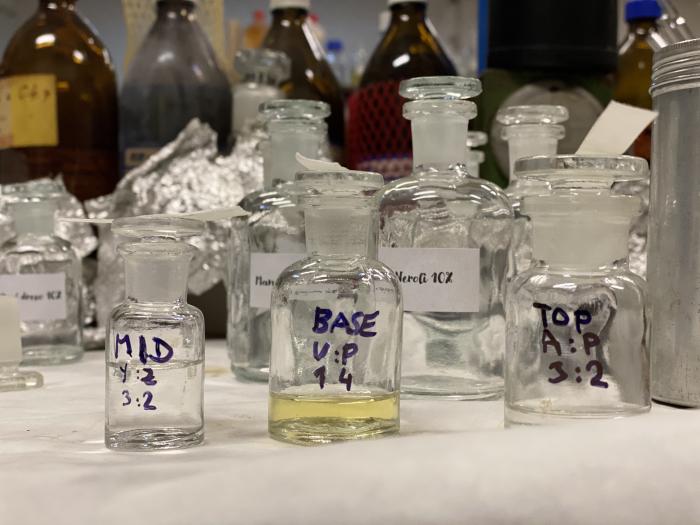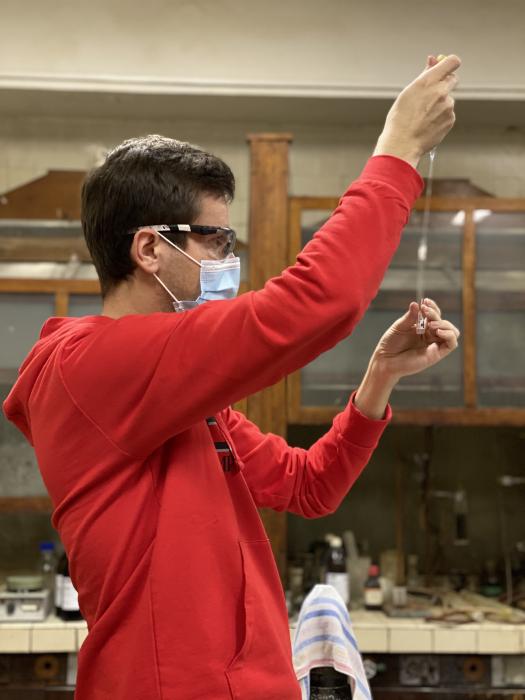I. SUMMARY INFORMATION
Project
269618
Status
Submitted
Award category
Techniques, materials and processes for construction and design
You want to submit
NEW EUROPEAN BAUHAUS AWARDS : existing completed examples
Project title
Breathe IN Breathe OUT
Full project title
Breathe IN Breathe - Future smell of biomaterials
Description
How to distinguish between natural and synthetic materials? The project Breathe IN Breathe OUT uses smell as a design tool to develop new aroma-active biomaterials to kick-off the yet to come world of circular consumption. The sense of smell is used to help the consumer to identify the raw material of bioplastics and to convey the material lifecycle with a unqiue smell. The developed fragances are an additional identifier of the material origin and applied in interior design and architecture.
Where was your project implemented in the EU?
Slovakia
Bratislava
Račianska 78
48.148598
17.107748
Bratislava
82103 Bratislava, Slovakia
When was your project implemented?
Has your project benefited from EU programmes or funds?
No
Which programme(s) or fund(s)? Provide the name of the programme(s)/fund(s), the strand/action line as relevant and the year.
II. DESCRIPTION OF THE PROJECT
Please provide a summary of your project
crafting plastics! studio & Office MMK started their research on the scent of the biobased bioplastics to create new aesthetics and opportunities for designing architecture and objects in 2018. The project Breathe IN / Breathe OUT investigates the emotional connection to different scents as a conscious response to circular economy and next step towards fully circular design. The first part of the research was exhibited during Milan Design Week 2019 (Alcova Milan) in the form of 3D printed bioplastic installation (pavilion) and 3D printed diffusers - objects infused by various scents. Since then there has been further development proceeding on the scents development for PHA/PLA type blends of bioplastic (by NUATAN) and the prototype of the first product - modular wall divider has been produced. The first material blends we are using are completely biobased and based on PHA - (metabolised by microorganisms from sugar) / PLA - (made from corn starch) as main ingredients.The sense of smell is used to help the consumer to identify the raw material of bioplastics and to convey the material lifecycle with a unqiue smell. The developed fragances are an additional identifier of the material origin. The developed proof-of-concept product is a modular room divider, f.e. for temporary offices or interiors in general. In 2021 the project aims to created a functional aroma formula and scented bioplastic product prototype. The project is currently exhibited at MAK, Vienna, as part of the CLIMATE CARE Vienna Biennal for Change 2021
Breathe In/ Breathe Out (2018 - ongoing): crafting plastics! studio, Office MMK
Collaborator (2020): Studio Omer Polak
Scent Development Collaboration (2019- ongoing): scientist Karol Červenčík - food aroma scientists from Slovak University of Technology
Breathe IN/ Breathe Out was funded by Fritz und Trude Fortmann-Stiftung für Baukultur und Materialien.
Please give information about the key objectives of your project in terms of sustainability and how these have been met
Using smell as a design tool for future materials structures relationships with not yet known materials and plays a key role in the societal acceptance of future materials such as bioplastics. The project is developed with 100% biobased polymer blends, which are completely recyclable and biodegradable. The products are manufactured by using 3D printing technology and solely natural ingredients for the essences are used. The novel approach presents a new method for creating sustainable products using scented bio materials.
Please give information about the key objectives of your project in terms of aesthetics and quality of experience beyond functionality and how these have been met
To improve the look, feel and especially the smell of future materials is one of the most important features of the project. In order to achieve the above targets, the products are developed in an interdisciplinary design method combining design, technology and manufacturing. The aesthetics of smell is not very well researched but plays a crucial role in the emotional acceptance as well as the overall perception of future materials. We think sustainability should also be seductive, work actively with our senses and create new aesthetics.
Please give information about the key objectives of your project in terms of inclusion and how these have been met
We encourage interaction and give citizens the opportunity to interact with the project at exhibitions. Different smells offer different ways to engage with the products. The elements of the modular room divider are very playful and can be combined easily by everyone - even children.
Please give information on the results/impacts achieved by your project in relation to the category you apply for
In 2019 the project has been presented at Milan Design Week and is currently shown at MAK, Vienna, as part of the CLIMATE CARE Vienna Biennal for Change 2021. Over the past three years several product prototypes have been developed and presented to the general public. The project has been supported by the Fritz und Trude Fortmann Stiftung and Slovak Art Council.
Please explain the way citizens benefiting from or affected by the project and civil society have been involved in the project and what has been the impact of this involvement on the project
The smells are developed in collaboration with citizens by presenting the project a public events and involving citizens in the design process of the smell. Feedback of citizens is used to improve the aesthetics of the project and to develop the smells further. Over the past three years, the project has received very positivite feedback of citizens which has helped to develop the smells.
Please highlight the innovative character of the project
The innovation of the project is to create an additional material identifier for bioplastics which is both pleasant but also helps citizens to identify the raw materials to be able to recycle the product. One of the key barriers of the implementation of bioplastics is that it is not possible to distinguish bioplastics from petrol-based plastics. Using the sense of smell to identify the material is the innovative character of the project.
Please explain how the project led to results or learnings which could be transferred to other interested parties
The project has an interdisciplinary approach combining material science, chemistry, biotechnology, aroma science, product design, sustainable architecture and is developed by a group of PhD students as part of their PhD research. The aim of the collaboration is to create a method to design smells which can be transferred to other industries.
Is an evaluation report or any relevant independent evaluation source available?
No
III. UPLOAD PICTURES
IV. VALIDATION
By ticking this box, you declare that all the information provided in this form is factually correct, that the proposed project has not been proposed for the Awards more than once under the same category and that it has not been subject to any type of investigation, which could lead to a financial correction because of irregularities or fraud.
Yes

